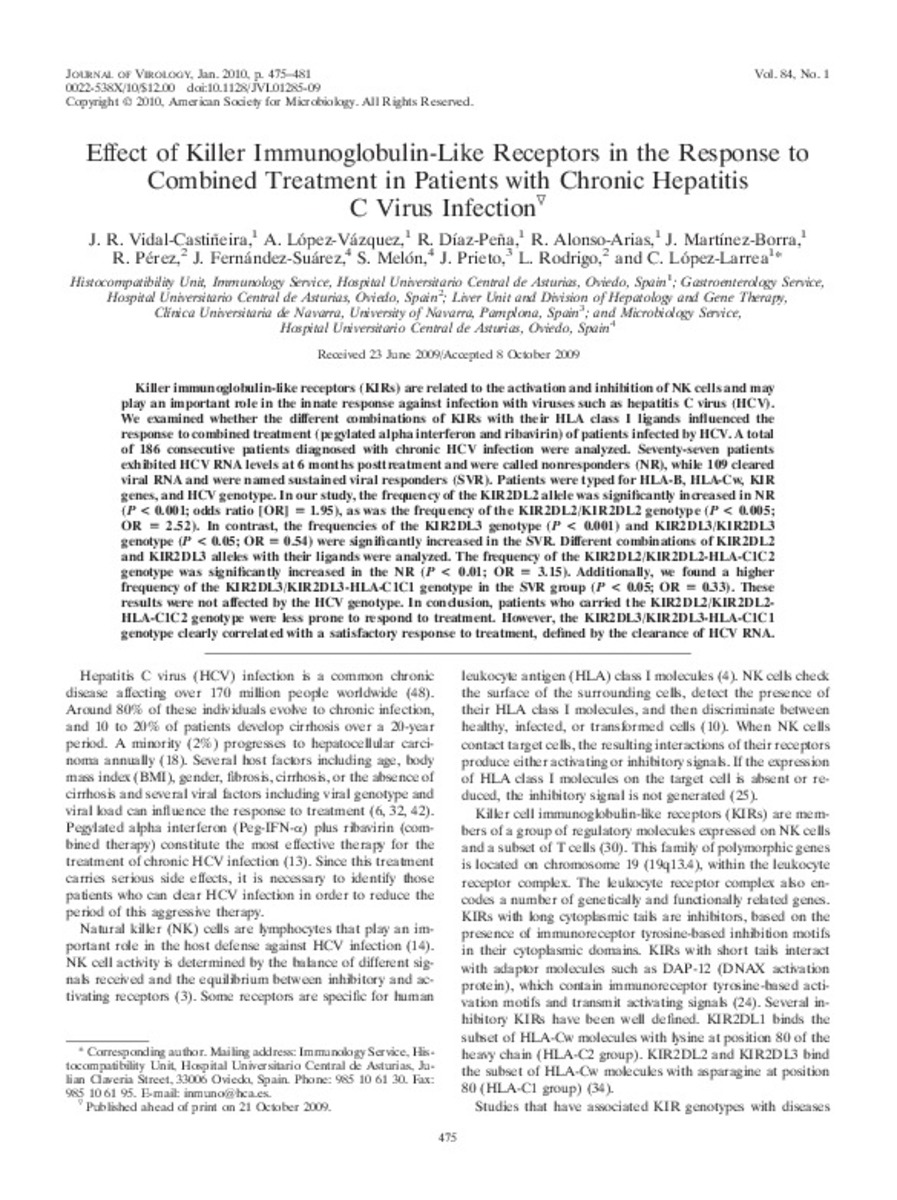Full metadata record
| DC Field | Value | Language |
|---|---|---|
| dc.creator | Vidal-Castiñeira, J.R. (Juan Ramón) | - |
| dc.creator | Lopez-Vazquez, A. (Antonio) | - |
| dc.creator | Diaz-Peña, R. (R.) | - |
| dc.creator | Alonso-Arias, R. (R.) | - |
| dc.creator | Martinez-Borra, J. (Jesús) | - |
| dc.creator | Perez, R. (R.) | - |
| dc.creator | Fernandez-Suarez, J. (J.) | - |
| dc.creator | Melon, S. (S.) | - |
| dc.creator | Prieto, J. (Jesús) | - |
| dc.creator | Rodrigo, L. (Luis) | - |
| dc.creator | Lopez-Larrea, C. (Carlos) | - |
| dc.date.accessioned | 2014-07-31T12:35:08Z | - |
| dc.date.available | 2014-07-31T12:35:08Z | - |
| dc.date.issued | 2010 | - |
| dc.identifier.citation | Vidal-Castiñeira JR, López-Vázquez A, Díaz-Peña R, Alonso-Arias R, Martínez-Borra J, Pérez R, et al. Effect of killer immunoglobulin-like receptors in the response to combined treatment in patients with chronic hepatitis C virus infection. J Virol. 2010 Jan;84(1):475-481 | es_ES |
| dc.identifier.issn | 0022-538X | - |
| dc.identifier.uri | https://hdl.handle.net/10171/36200 | - |
| dc.description.abstract | Killer immunoglobulin-like receptors (KIRs) are related to the activation and inhibition of NK cells and may play an important role in the innate response against infection with viruses such as hepatitis C virus (HCV). We examined whether the different combinations of KIRs with their HLA class I ligands influenced the response to combined treatment (pegylated alpha interferon and ribavirin) of patients infected by HCV. A total of 186 consecutive patients diagnosed with chronic HCV infection were analyzed. Seventy-seven patients exhibited HCV RNA levels at 6 months posttreatment and were called nonresponders (NR), while 109 cleared viral RNA and were named sustained viral responders (SVR). Patients were typed for HLA-B, HLA-Cw, KIR genes, and HCV genotype. In our study, the frequency of the KIR2DL2 allele was significantly increased in NR (P < 0.001; odds ratio [OR] = 1.95), as was the frequency of the KIR2DL2/KIR2DL2 genotype (P < 0.005; OR = 2.52). In contrast, the frequencies of the KIR2DL3 genotype (P < 0.001) and KIR2DL3/KIR2DL3 genotype (P < 0.05; OR = 0.54) were significantly increased in the SVR. Different combinations of KIR2DL2 and KIR2DL3 alleles with their ligands were analyzed. The frequency of the KIR2DL2/KIR2DL2-HLA-C1C2 genotype was significantly increased in the NR (P < 0.01; OR = 3.15). Additionally, we found a higher frequency of the KIR2DL3/KIR2DL3-HLA-C1C1 genotype in the SVR group (P < 0.05; OR = 0.33). These results were not affected by the HCV genotype. In conclusion, patients who carried the KIR2DL2/KIR2DL2-HLA-C1C2 genotype were less prone to respond to treatment. However, the KIR2DL3/KIR2DL3-HLA-C1C1 genotype clearly correlated with a satisfactory response to treatment, defined by the clearance of HCV RNA. | es_ES |
| dc.language.iso | eng | es_ES |
| dc.publisher | American Society for Microbiology | es_ES |
| dc.rights | info:eu-repo/semantics/openAccess | es_ES |
| dc.subject | Receptors, KIR | es_ES |
| dc.subject | Hepatitis C | es_ES |
| dc.subject | Humans | es_ES |
| dc.subject | Treatment outcome | es_ES |
| dc.title | Effect of killer immunoglobulin-like receptors in the response to combined treatment in patients with chronic hepatitis C virus infection | es_ES |
| dc.type | info:eu-repo/semantics/article | es_ES |
| dc.identifier.doi | http://dx.doi.org/10.1128/JVI.01285-09 | es_ES |
Files in This Item:
Statistics and impact
Items in Dadun are protected by copyright, with all rights reserved, unless otherwise indicated.






